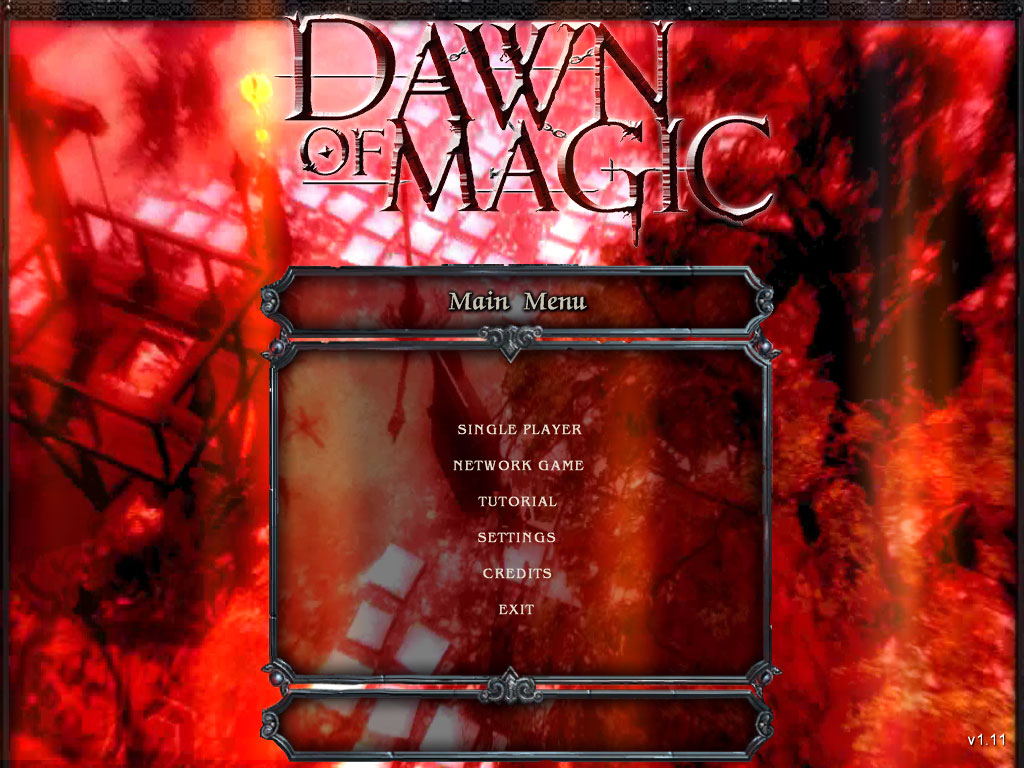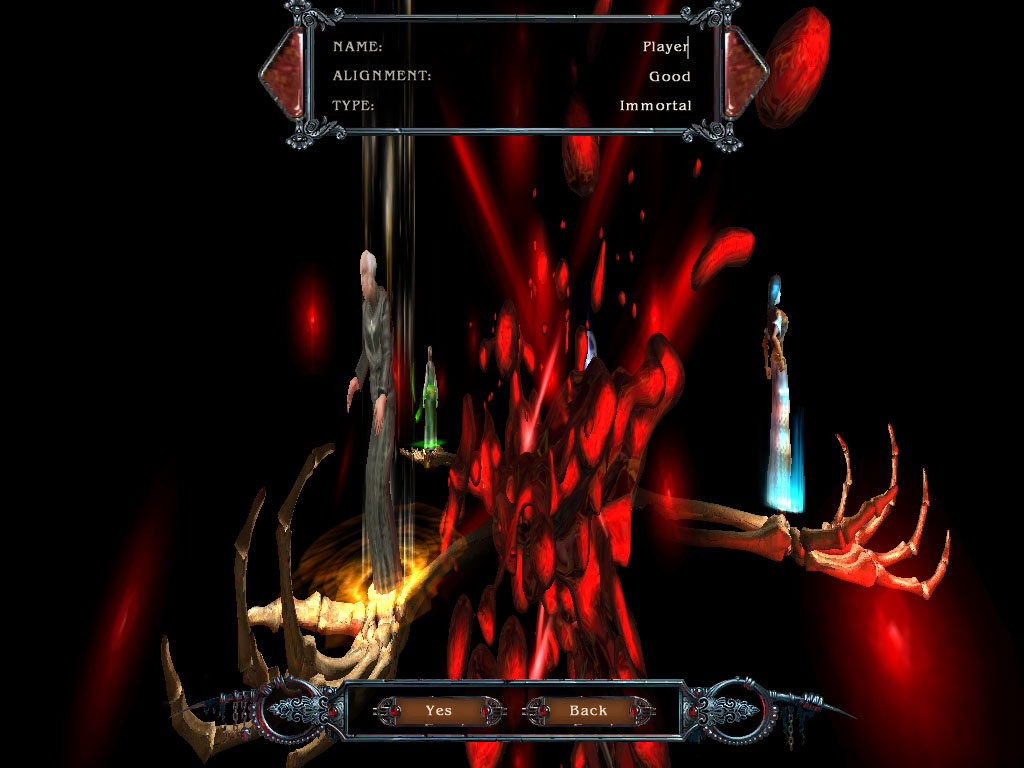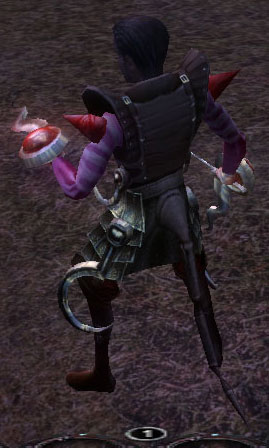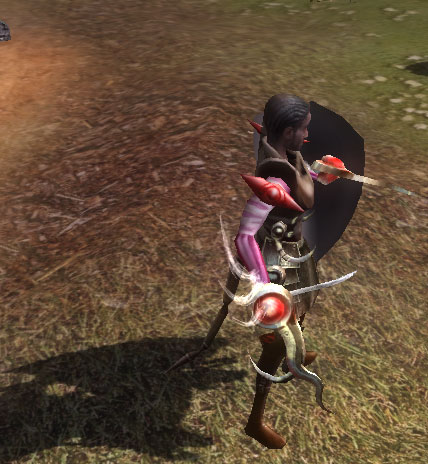Dawn of Magic
So for my first game review here at Uninformed Gamer, I did exactly what I promised I’d do: I walked into a game store, pulled out a game I had never ever heard of, bought it, and left.
I tend to like RPGs and the box art was pretty, so here I am with my very own copy of Dawn of Magic. I have no idea who makes this game or when it was released, if you find yourself in need of this information, google it.
First impressions: The box is nice, the name is kinda cool. The screenshots are small and pixilated, but they show promise. I haven’t really read much of the outside of the box, but a quick scan turns up fun figures like “more than 600 NPCs” and “More than 1500 weapons and pieces of armor” Well I like games with lots of STUFF.
Play Time:
Step 1: open the box. This is a PC DVD and comes in one of those over-sized DVD cases that looks like it should hold about 20 disks… but low and behold, there’s just the one. One disk and a pretty thin manual, what more do you need? I tend to regard manuals in about the same vein as game magazines, but I keep them around incase I get totally lost.
Step 2: installation. As you may recall I am running Windows 2003, so no autoexe. In my computer, the little disk icon says ‘DOM’, and it’s in my P:\ Drive for some reason. Actually that reason is because I have lots of external drives and have already worked my way up to P.
Installation is a pretty straight foreword affair. It’s a simple installer that lets you keep working in the background, not one of those annoying full-screen ones that consume more system resources than the game.
Step 3: play! Game launches predictably enough, lots of fun title videos for the various folks who worked on it. I’ve probably heard of some of them, I bet you have to.
The opening screen is simplistic.

Now, before I move forward, let me briefly explain how I tend to rate RPGs. I like hitting things with swords. So, when I launch the game, I basically start a mental timer. The less time elapsed between the launch of a new game and me hitting something with a sword, the higher the game scores.
There are obviously other considerations, but really I like swords. Any game that starts the player off with only a stick fails epically.
At the character creation screen, we encounter our first issue:

I can’t say whether or not the game is supposed to look this way, but I certainly hope not. It may just be the peculiar nature of my setup, but that just looks weird. I’ll say this though: the game alt-tabs admirably.
The game gives you four characters to start from: a weird gypsy, a fat baker’s wife, an old friar, and a total wuss of a scholar. For my digital avatar I chose the scholar, because he reminds me of me.
Each character has its strengths and weakness, but I’m not going to dive to much into that.
The loading screen is nice and bloody, which I like, and actually asks you to hit a mouse button or key before starting the game. This is also nice because I sometimes like to walk away from my loading screens. And then I get eaten by raptors.
There was a weird effect happening on my screen, but I was able to remedy that by adjusting the screen resolution:

Hellllooooooo surround-gaming experience! I think I appreciate this game already. You get a bit of a fish-eye experience looking at the screencap on a normal monitor, but from my screen it actually looks just fine. See, my monitors are arranged in a U shape and I look at the middle one, taking in the sides out of the corner of my eyes. The complete FOV is about 130 degrees, slightly less than the 180 the human eye is used to. Seeing the other screens from the corner of your eye, they actually look great. Try it some time, the device is called a TrippleHead2Go, by Matrox.
Camera controls are a bit none-intuitive, but since I’ve figured out how to walk and break stuff without the manual, I figure this game does ok on the controls.
Running through some kind of magic academy, nobody said anything as I proceeded to smash everything in sight.

One student did eventually ask me if I’d gone mad, but who cares? There’s gold in them thar breakable stuff!
My first enemy in the game was a giant spider, which I proceeded to beat the ever living tar out of with my bare fists. I have to say, I may not have gotten to hit something with a sword very early on, but I did get to break stuff and punch a giant spider!
Psychology is a very interesting aspect of game designs. If you want to make scary games, get a psych degree. I am arachnophobia, spiders scare me. Spiders in videogames also scare me, but I keep playing because they can’t hurt me! So I get to enjoy being scared, and I do.

Why does my character have a tail? That wasn’t there before!
My character seems to be getting more and more bad-ass without much input from me.

Kudos, Awkward Scholar, kudos…
Story/Plot:
My first task in the game was to select three areas of magic to specialize in. After some thought, I chose Light Magic, Fire Magic, and Bone Magic.
A significant portion of my quests consisted of ‘go out beyond the city walls and kill X of these creatures’. Thanks guys, I really needed lessons in grinding.
I imagine the game fancies itself as having a very deep plot, but I for one could not see any of it. I start the game off as some kind of awkward scholar who, for some reason, has thief armor, and proceed to run around hacking and slashing my away through loads of monsters, progressively becoming more bad-ass in appearance.
After doing one grinding quest and proving to everything in the starting area that I was ‘the man’, I proceeded on to the next area, where I killed a bunch more things and broke a lot of stuff, and then finally found the fellow I was told to see, who proceeded to give me ANOTHER grinding quest.
That was as far as I got before the annoying view angle and running around in circles got old.
Environments/Graphics:
First thought about the environments are pretty nice. The models are simple and low-polly, good for hack’n’slash, most everything is breakable, and the textures look pretty good. The scale is good; I don’t feel like a mouse or a giant.
One of the things that’s kind of neat is the zoom-feature. You can zoom out to where your avatar is a tiny patch of pixels dancing across the screen, which lets you see a lot of the map around you and is helpful for navigating, and you can also zoom in until you are chase-caming your avatar. Unfortunately the camera doesn’t actually chase-cam all that well, and if you turn around suddenly your avatar will be running right towards you.
Once the screen res was fixed, the models looked pretty good. Clearly they are not normal-mapped, and I’m sure many people would disagree with my definition of ‘good’, but take a look at where I’m coming from: I understand how poly-count affects game play, and I would rather have a fast, smooth gaming experience, than a 50,000-tri character who can actually perform facial expressions. The character models in Dawn of Magic are low-poly, but they are also well-rigged and animated, and are really at an acceptable level.
One thing that bares not is the idle animations: whenever I let my character stand still, he would fidget and move uncomfortably, giving him this really edgy feel. It’s just a small detail that adds depth to the game, and deserves a sticker for whoever added it.
Over all the environments are pleasant, simplistic, yet detailed. They give the emphasis to exploration and discovery, but still provide a smooth experience for hacking and slashing and of course, breaking stuff!
Personally, I like it.
The art team really did a fantastic job on the environments, unfortunately, the poor camera system makes it difficult to enjoy their work.
Interface/Controls:
The movement controls could use some work. I would prefer a WASD interface over the point-and-click the game actually uses. Camera controls are also a tad cumbersome, but again that may be my surround-gaming setup.
For a hack’n’slash title, the movement system and lack of chase-caming seems odd. Apparently the designers expected you to keep one hand on the ‘z’ key for spaming potions, then of course failed to provide you with a reasonable way to count how many you actually had(I THOUGHT I had 600…).
The inventory shows you what each item is worth, but not how many you actually have, unless you are in a trade window. Trading is perfectly straightforward though; you simply toss items you want to trade in one spot and items they have ylou want in another and hit ‘trade’.
The magic system has a bit of a twist. Instead of hot-keying spells, you hotkey an active spell. Hitting the hotkey(numbers 1-9) makes that spell ‘active’, then you use it with the left mouse button. Since the active spell also has a passive effect, this makes a certain amount of sense. There really isn’t much cause to hotkey between the spells very often; you pretty much need a ranged one and an area-effect one. You may also want to vary according to monster weaknesses, but most of the monsters seemed to be weak to just about everything (especially my bone-sharded fist in their faces!).
The controls are pretty much so-so. Not the greatest, but far from unplayably bad. Again, I would have preferred WASD, but what are you gonna do?
Design:
There are quite a few activators in the game, the trouble is, it’s impossible to tell until you click on something whether or not you are going to bash it open for gold, or get a message from it. This can get very annoying, because apparently people get angry when you smash there stuff.
The map system is not very good. A significant portion of my time spent in any given area involved lots of running around in circles looking for an opening in the city gates or a quest giver. I like that. Wait… no, no I don’t like that! I don’t like that at all!
Dieing in the game is not so bad. The designers but a heavy emphasis on blood (which was AWESOME, by the way), so when you die you get a bunch of blood dripping across your screen, then you drop all your money and show up back at the teliporter gate with full health and no experience penalties.
After one of my various death-capades, I was able to return to the site of my demise, retrieve my lost gold, and even pick up my own skull! Now that is a cool feature.
Unfortunately, the primary failing of the game appears to be in this design. Drinking potions is a heavily emphasized part of the game; unfortunately they are unbelievably expensive, and every time your avatar dies, he looses all his money.
The inventory system is just god-awful. The all your items appear in a scroll-bar along the bottom. For a game boasting ‘1500 unique items’, this really doesn’t sound like a great approach.
Performance:
Performance-wise the game definitely gets a gold-star. Not only did it provide support for my wacky screen resolution, it just ran great in general! The game play was never jerky or awkward, and the loading screens were kept to a minimum. And, as I mentioned, it handled alt-tabing out to write this review with remarkable ease. I didn’t play with any of the higher graphics settings, but it looked good from where I sat.
The End Result:
Over all the game ranks as so-so, a solid two and a half stickers.



Basically, it’s ok, but not great. It has some possibility to be great, and is highly playable and really pretty easy. But the annoying control scheme and poor camera angles really killed it.
There were some innovative features and a lot of things done right. But it also gets repetitive quickly, and I didn’t see much of a story while I was there.
And don’t tell me ‘you have to play more to get into the game’, that’s like saying you have to read the first three chapters of a book to get into it. If a book doesn’t suck me in on the first page, I probably won’t make it to the second. Video game designers can learn a lot from writers, the same techniques that draw the reader into a good book draw the player into a good game. I could draw parallels until the cows come home, but I won’t.
Final thought: if you’re really into hack’n’slash and don’t mind repetition, you will love Dawn of Magic. It apparently has a humongous world for you to hack and/or slash things in. Far from bad, but not that close to good either.









